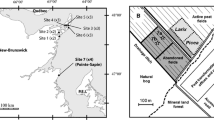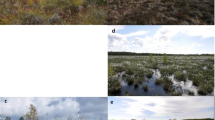Abstract
The objective of this study was to examine plant community development and peat stratigraphy in the context of ground-water flow systems for five forested peatlands in central New York State for which extensive vegetation, surface hydrology, and water chemistry analyses has been performed. Peatland development trends, from the initial period of peat accumulation to the present, were explored using peat stratigraphy, analysis of ground-water flow systems and evidence from existing vegetation. Detailed analyses, including the construction of numerical ground-water models were performed for one of the five sites to examine the process of bog development within what was once a highly calcareous fen and to examine the impacts of agricultural drainage on peatland ground-water flow. Peat stratigraphy analysis indicated two pathways of peatland development: infilling of shallow lakes and peat accumulation on ground-water seeps. Lake-infill peatlands were characterized by a sequence of limnic peat→ bryophyte-sedge peat→hemic-fibric sedge peat→sapric wood peat (orSphagnum peat). Analysis of ground-water flow systems indicated that four of the peatlands were characterized by mineral-rich ground-water discharge along peatland margins, with lateral flow through the peatlands towards drainage features. The fifth peatland was characterized by a more complex ground-water flow system with a weakly minerotrophic water-table mound driving shallow ground-water recharge flow. The water-table mound has been reduced in extent by agricultural drainage and demonstrates seasonal fluctuations in hydraulic head and areal extent.
Similar content being viewed by others
Literature Cited
Anderson M.P. and W.W. Woessner. 1992. Applied groundwater modeling: simulation of flow and advective transport. Academic Press, New York, NY, USA.
Andrus, R.E. 1986. Some aspects ofSphagnum ecology. Canandian Journal of Botany 64:416–426.
Bernard, J.M., F.K. Seischab, and H.G. Gauch. 1983. Gradient analysis of the vegetation of the Bryon-Bergen swamp, a rich fen in western New York. Vegetatio 53:85–91.
Bickelhaupt, D.H. and E.H. White. 1982. Laboratory manual for soil and plant tissue analysis. State University of New York, College of Environmental Science and Forestry, Syracuse, NY, USA.
Boelter D.H. 1974. The hydrologic characteristics of undrained organic soils in the lake states. p. 33–46.In A.R. Aandahl, S.W. Buol, D.E. Hill, and H.H. Bailey (eds.) Histosols: Their Characteristics, Classification, and Use. Soil Science Society of America, Madison, WI, USA. Soil Science Society of America Special Publication Series, number 6.
Boeye, D., D. van Straaten, and R.F. Verheyen. 1995. A recent transformation from poor to rich fen caused by artificial groundwater recharge. Journal of Hydrology 169:111–129.
Boigeol, M. 1965. Life along Hall Road. p. 42–60.In Publication 27, Oswego County Historical Society, Oswego, NY, USA.
Bonde, A.N., J.D. Ives, and D.B. Lawrence. 1961. Ecosystems studies at Cedar Creek Natural History Area III: water use studies. Minnesota Academy of Science Proceedings 29:190–198.
Chason, D.B. and D.I. Siegel. 1986. Hydraulic conductivity and related physical properties of peat, Lost River peatland, Northern Minnesota. Soil Science 142:91–99.
Clymo, R.S. 1973. The growth ofSphagnum. Some effects of measurement. Journal of Ecology 61:849–869.
Collins, S.L., J.V. Perino, and J.L. Vankat. 1982. Woody vegetation and microtopography in the bog meadow association of Cedar Bog, a west-central Ohio fen. American Midland Naturalist 108: 245–249.
Cox, D.D. 1959. Some post glacial forests in central and eastern New York State as determined by the method of pollen analysis. NY State Museum of Science Service, Bulletin Number 377
Crum, H. 1983. Mosses of the Great Lakes Forests, 3rd ed. University of Michigan Herbarium, Ann Arbor, MI, USA.
Crum, H. 1988. A Focus on Peatlands and Peat Mosses. University of Michigan Press, Ann Arbor, MI, USA.
Damman A.W.H. and T.W. French. 1987. The ecology of peat bogs of the glaciated northeastern United States: a community profile. U.S. Fish and Wildlife Service, Washington, DC, USA. Biological Report 85 (7.16).
Dansereau, P. and F. Segadas-Vianna. 1952. Ecological study of the peat bogs of eastern North America: I. Structure and evolution of vegetation. Canadian Journal of Botany 30:490–520.
Domenico, P.A. and F.W. Schwartz. 1990. Physical and Chemical Hydrogeology. John Wiley and Sons, New York, NY, USA.
Frederick, C.M. 1974. A natural history study of the vascular flora of Cedar Bog, Champaign County, Ohio. Ohio Journal of Science 74:65–116.
Glaser, P.H., G.A. Wheeler, E. Gorham, and H.E. Wright, Jr. 1981. The patterned mires of Red Lake peatlands, northern Minnesota: vegetation, water chemistry and land forms. Journal of Ecology 69:575–599.
Glaser, P.H. 1992. Vegetation and water chemistry. p. 15–26.In H. E. Wright, Jr., B.A. Coffin, and N.E. Aaseng (eds.) The Patterned Peatlands of Minnesota. University of Minnesota Press, Minneapolis, MN, USA.
Glaser, P.H., J.A. Janssens, and D.I. Siegel. 1990. The response of vegetation to chemical and hydrological gradients in the Lost River peatland, northern Minnesota. Journal of Ecology 78:1021–1048.
Golet, F.C., A.J.K. Calhoun, W.R. Deragon, D.J. Lowry, and A.J. Gold. 1993. Ecology of red maple swamps in the glaciated northeast: a community profile. U.S. Fish and Wildlife Service, Washington, DC, USA. Biological Report 12.
Grieve, I.C., D.G. Gilvear, and R.G. Bryant. 1995. Hydrochemical and water source variations across a floodplain mire, Insh Marshes, Scotland. Hydrologic Processes. 9:99–110.
Heinselman, M.L. 1970. Landscape evolution, peatland types, and the environment in the Lake Agassiz Peatland Natural Area, Minnesota. Ecological Monographs 40:235–261.
Hvorslev, M.T. 1951. Time lag and soil permeability in groundwater observations. U.S. Army Corps of Engineers, Waterways Experiment Station, Vicksburg, MS, USA. Bulletin 36
Iorizzo, L.J. 1968. The history of Italians in Oswego, Part I. p. 88–112.In Publication 29, Oswego County Historical Society, Oswego, NY, USA.
Juusela, T., S. Kaunisto, and S. Mustonen. 1970. Turpeesta Tapahtuvann Haidhduntaan
Vaikuttavista Tekijoista (On factors affecting evapotranspiration from peat). Communicationes Instituti Forestalis Fenniae 67:45.
Kratz, T.K. and C.B. DeWitt. 1986. Internal factors controlling peatland-lake ecosystem development. Ecology 67:100–107.
McLay, C.D.A., R.F. Allbrook, and K. Thompson. 1992. Effect of development and cultivation on physical properties of peat soils in New Zealand. Geoderma 54:23–37.
McNamara, J.P., D.I. Siegel, P.H. Glaser, and R.M. Beck. 1992. Hydrogeological controls on peatland development in the Malloryville Wetland, New York (USA). Journal of Hydrology 140:279–296.
Micro-innovations, Inc. 1993. Graphic groundwater, version 1.1. Micro-innovations, Inc., Carbondale, IL, USA.
Miller, T.S. 1980. Surficial geology of Pennelville Quadrangle. Oswego County, New York. USGS Water-Resources Investigation. Open-File Report 80–411.
Muller, E.H. and T.S. Miller. 1980. Surficial geology of Central Square Quadrangle. Oswego County, New York. USGS Water-Resources Investigation Open-File Report 80-2039. Northeast Regional Climate Center. 1993. New York Climate. Vol. 93. Cornell University, Ithaca, NY, USA. Northeast Regional Climate Center. 1994. New York Climate. Vol. 94. Cornell University, Ithaca, NY, USA.
Rapparlie, D.F. 1981. Soil survey of Oswego County, New York. USDA Soil Conservation Service. Washington, DC, USA.
Rickard, L.V. and D.W. Fisher. 1970. Geologic map of New York, Finger Lakes sheet. N.Y. State Museum Science Service, Map and Chart Series number 15.
Rowlee, W.W. 1897. The swamps of Oswego County, N. Y. and their flora. American Naturalist 31:690–699, 792–801.
Rycroft, D.W., D.J.A. Williams, and H.A.P. Ingram. The transmission of water through peat: II field experiments. Review Journal of Ecology 63:557–568.
Seischab, F.K. and J.M. Bernard. 1985. Early plant succession on marl beds in the Byron-Bergen swamp. Bartonia 51:58–64.
Sheldon, R.E. 1952. Pollen analysis of central New York bogs. Ph.D. Thesis. Syracuse University, Syracuse, NY, USA.
Siegel, D.I. 1983. Ground water and the evolution of patterned mires, Glacial Lake
Agassiz Wetlands, northern Minnesota. Journal of Ecology 71:913–921.
Siegel, D.I. 1988. The recharge-discharge function of wetlands near Juneau, Alaska: Part I.
Hydrogeological investigations. Ground Water 26:427–434.
Siegel, D.I. 1992. Groundwater hydrology. p. 163–172.In H.E. Wright, Jr., B.A. Coffin, and N.E. Aaseng (eds.) The Patterned Peatlands of Minnesota. University of Minnesota Press, Minneapolis, MN, USA.
Siegel, D.I. and P.H. Glaser. 1987. Groundwater flow in a bog/fen complex, Lost River Peatland, northern Minnesota. Journal of Ecology 75:743–754.
Siegel, D.I. and T.C. Winter. 1980. Hydrogeologic setting of Williams Lake, Hubbard County, Minnesota. USGS Open-File Report. 80–403.
Sjörs, H. 1950. On the relation between vegetation and electrolytes in north Swedish mire waters. Oikos 2:241–258.
Teskey, R.O. and T.M. Hinckley. 1978a. Impact of water level changes on woody riparian and wetland communities, vol. IV: Eastern deciduous forest region. U.S. Fish and Wildlife Service, Washington, DC, USA. Biological Service Program FWS/OBS-78/87.
Teskey, R.O. and T.M. Hinckley 1978b. Impact of water level changes on woody riparian and wetland communities, vol. V: Northern forest region. U.S. Fish and Wildlife Service, Washington, DC, USA. Biological Service Program FWS/OBS-78/88.
Thornthwaite, C.W. 1948. An approach toward a rational classification of climate. Geography Review 38:55–94.
Wang, H.F. and M.P. Anderson. 1982. Introduction to Groundwater Modeling: Finite Difference and Finite Element Methods. W.H. Freeman. New York, NY, USA.
Wibbe, J.H. 1877. Oswego plants. Bulletin of the Torrey Botanical Club 6:192.
Zoltai, S.C. and J.D. Johnson. 1985. Development of a treed bog island in a minerotrophic fen. Canadian Journal of Botany 63: 1076–1085.
Author information
Authors and Affiliations
Corresponding author
Rights and permissions
About this article
Cite this article
Podniesinski, G.S., Leopold, D.J. Plant community development and peat stratigraphy in forested fens in response to ground-water flow systems. Wetlands 18, 409–430 (1998). https://doi.org/10.1007/BF03161534
Received:
Revised:
Accepted:
Issue Date:
DOI: https://doi.org/10.1007/BF03161534




